Hazard and Environment Analysis of Bioethanol Project in Sweden
VerifiedAdded on 2023/04/25
|8
|1144
|244
Report
AI Summary
This report provides a hazard and environmental analysis of a bioethanol project, focusing on a case study in Sweden. It identifies potential hazards such as gas leaks, chemical emissions, and health risks associated with bioethanol exposure, along with their corresponding risk mitigation strategies and involved regulations. The environmental impact assessment highlights both the benefits, such as reduced greenhouse gas emissions, and the drawbacks, including acidification, photochemical oxidation, and water toxicity. The report also outlines the relevant environmental codes of practice in Sweden, emphasizing the need for safety measures, risk assessment procedures, and the use of best available technologies to minimize environmental damage. The analysis incorporates life cycle inventory and impact assessment methodologies to evaluate the overall sustainability of bioethanol production from sugar beet crops, while also noting the importance of addressing issues like soil degradation and water pollution through appropriate cultivation and management practices. Desklib offers a range of solved assignments and study resources for students.

Running head: HAZARD AND ENVIRONMENT ANALYSIS OF BIOETHANOL PROJECT
Name of the student:
Name of the university:
Author note:
Name of the student:
Name of the university:
Author note:
Paraphrase This Document
Need a fresh take? Get an instant paraphrase of this document with our AI Paraphraser
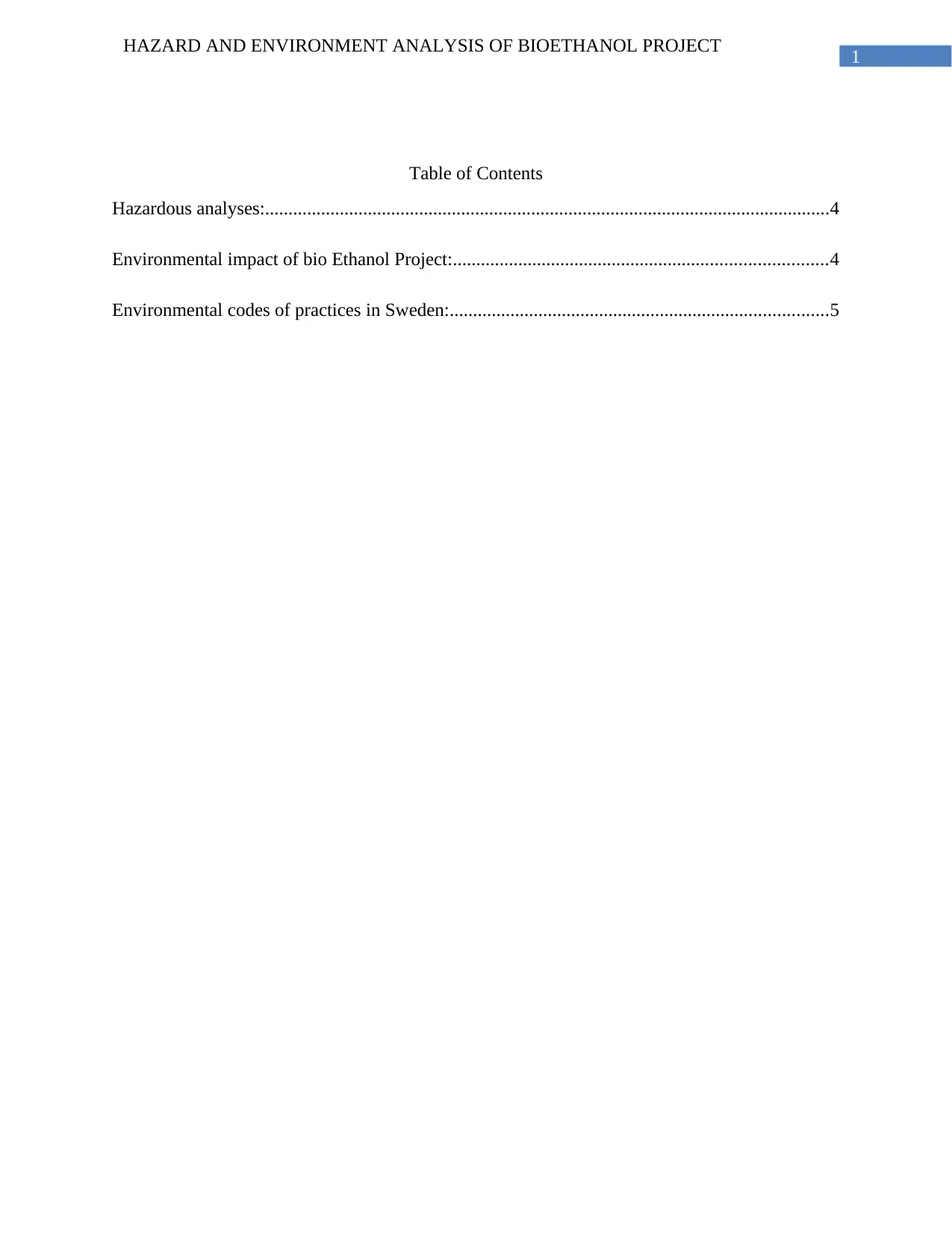
1
HAZARD AND ENVIRONMENT ANALYSIS OF BIOETHANOL PROJECT
Table of Contents
Hazardous analyses:.........................................................................................................................4
Environmental impact of bio Ethanol Project:................................................................................4
Environmental codes of practices in Sweden:.................................................................................5
HAZARD AND ENVIRONMENT ANALYSIS OF BIOETHANOL PROJECT
Table of Contents
Hazardous analyses:.........................................................................................................................4
Environmental impact of bio Ethanol Project:................................................................................4
Environmental codes of practices in Sweden:.................................................................................5
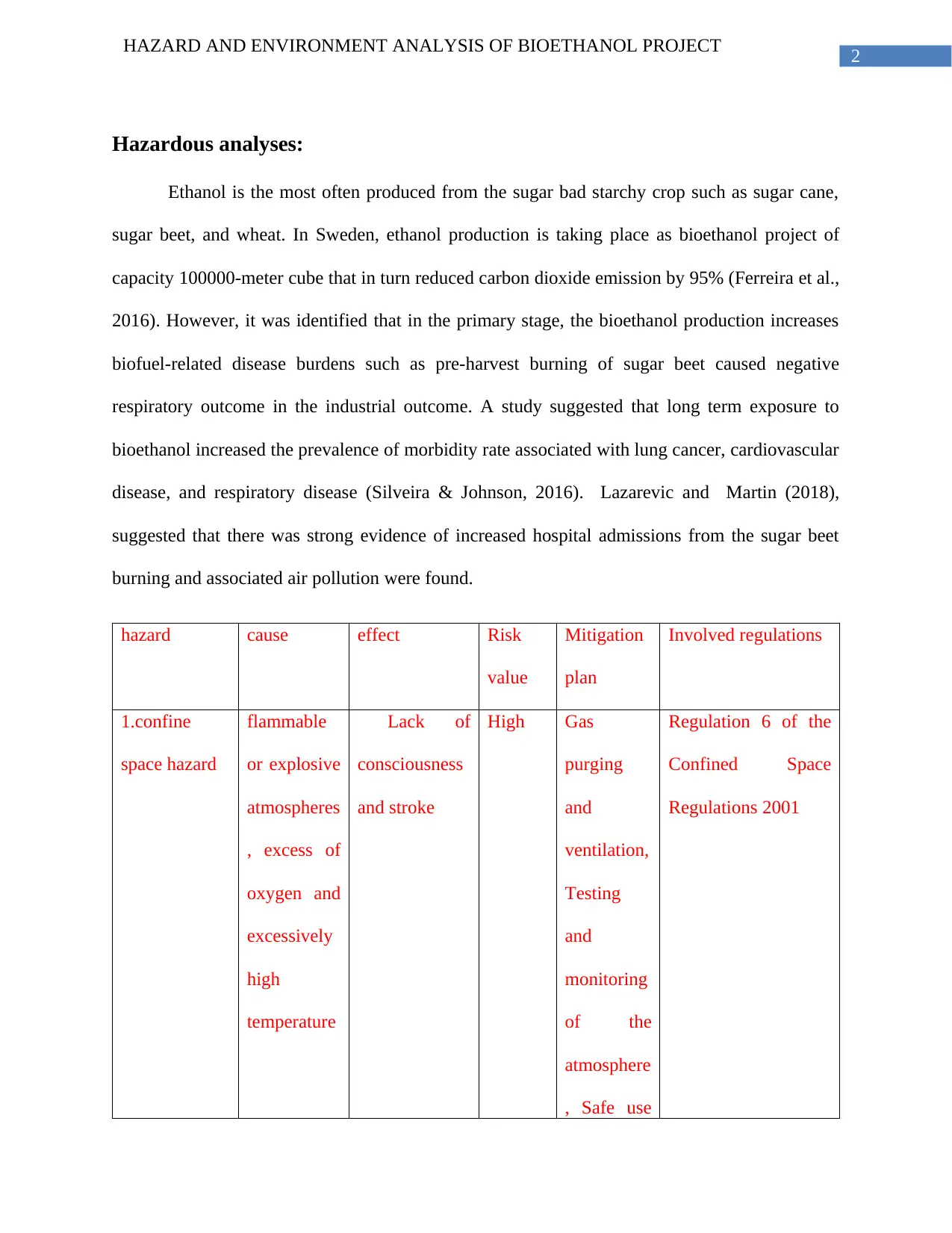
2
HAZARD AND ENVIRONMENT ANALYSIS OF BIOETHANOL PROJECT
Hazardous analyses:
Ethanol is the most often produced from the sugar bad starchy crop such as sugar cane,
sugar beet, and wheat. In Sweden, ethanol production is taking place as bioethanol project of
capacity 100000-meter cube that in turn reduced carbon dioxide emission by 95% (Ferreira et al.,
2016). However, it was identified that in the primary stage, the bioethanol production increases
biofuel-related disease burdens such as pre-harvest burning of sugar beet caused negative
respiratory outcome in the industrial outcome. A study suggested that long term exposure to
bioethanol increased the prevalence of morbidity rate associated with lung cancer, cardiovascular
disease, and respiratory disease (Silveira & Johnson, 2016). Lazarevic and Martin (2018),
suggested that there was strong evidence of increased hospital admissions from the sugar beet
burning and associated air pollution were found.
hazard cause effect Risk
value
Mitigation
plan
Involved regulations
1.confine
space hazard
flammable
or explosive
atmospheres
, excess of
oxygen and
excessively
high
temperature
Lack of
consciousness
and stroke
High Gas
purging
and
ventilation,
Testing
and
monitoring
of the
atmosphere
, Safe use
Regulation 6 of the
Confined Space
Regulations 2001
HAZARD AND ENVIRONMENT ANALYSIS OF BIOETHANOL PROJECT
Hazardous analyses:
Ethanol is the most often produced from the sugar bad starchy crop such as sugar cane,
sugar beet, and wheat. In Sweden, ethanol production is taking place as bioethanol project of
capacity 100000-meter cube that in turn reduced carbon dioxide emission by 95% (Ferreira et al.,
2016). However, it was identified that in the primary stage, the bioethanol production increases
biofuel-related disease burdens such as pre-harvest burning of sugar beet caused negative
respiratory outcome in the industrial outcome. A study suggested that long term exposure to
bioethanol increased the prevalence of morbidity rate associated with lung cancer, cardiovascular
disease, and respiratory disease (Silveira & Johnson, 2016). Lazarevic and Martin (2018),
suggested that there was strong evidence of increased hospital admissions from the sugar beet
burning and associated air pollution were found.
hazard cause effect Risk
value
Mitigation
plan
Involved regulations
1.confine
space hazard
flammable
or explosive
atmospheres
, excess of
oxygen and
excessively
high
temperature
Lack of
consciousness
and stroke
High Gas
purging
and
ventilation,
Testing
and
monitoring
of the
atmosphere
, Safe use
Regulation 6 of the
Confined Space
Regulations 2001
⊘ This is a preview!⊘
Do you want full access?
Subscribe today to unlock all pages.

Trusted by 1+ million students worldwide
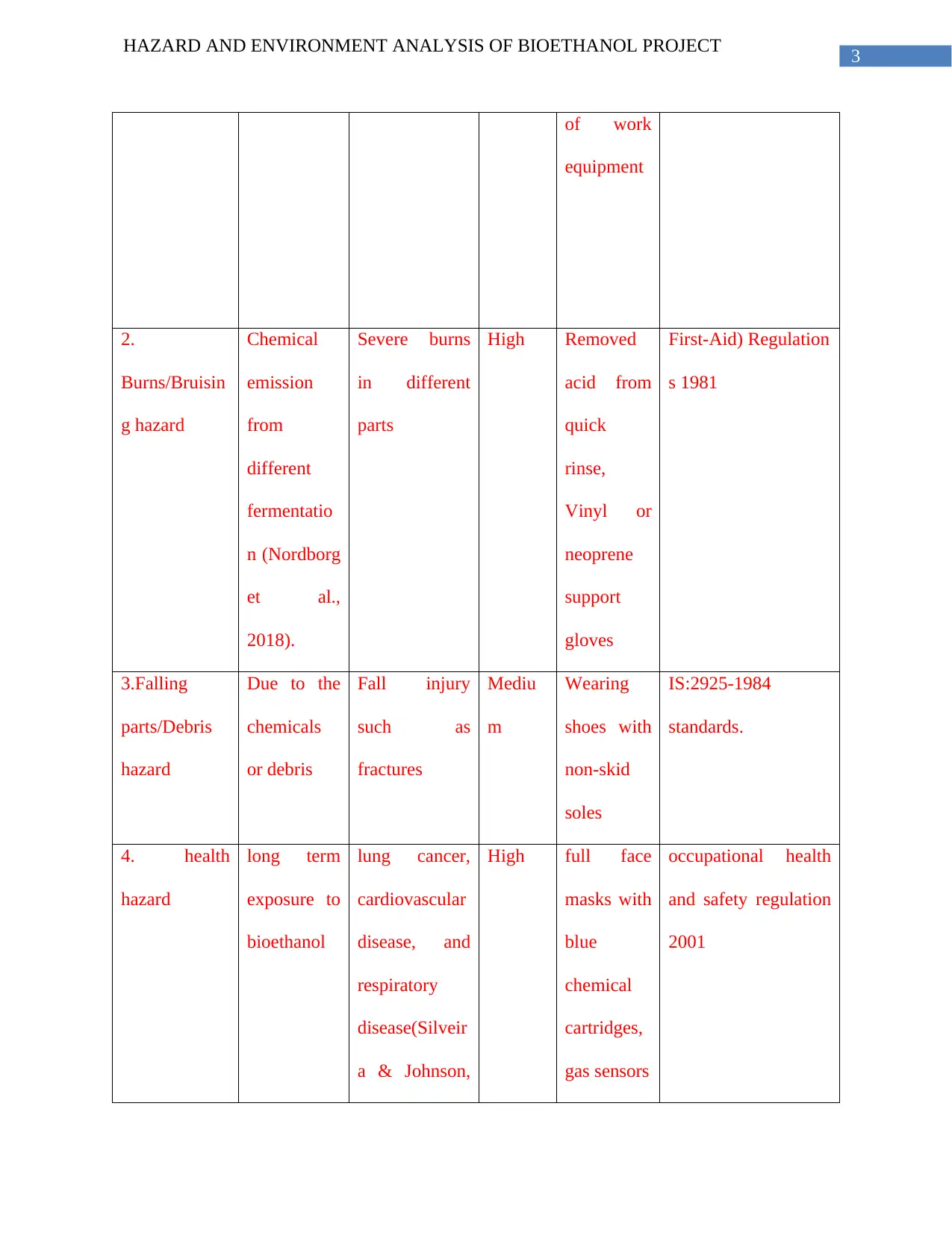
3
HAZARD AND ENVIRONMENT ANALYSIS OF BIOETHANOL PROJECT
of work
equipment
2.
Burns/Bruisin
g hazard
Chemical
emission
from
different
fermentatio
n (Nordborg
et al.,
2018).
Severe burns
in different
parts
High Removed
acid from
quick
rinse,
Vinyl or
neoprene
support
gloves
First-Aid) Regulation
s 1981
3.Falling
parts/Debris
hazard
Due to the
chemicals
or debris
Fall injury
such as
fractures
Mediu
m
Wearing
shoes with
non-skid
soles
IS:2925-1984
standards.
4. health
hazard
long term
exposure to
bioethanol
lung cancer,
cardiovascular
disease, and
respiratory
disease(Silveir
a & Johnson,
High full face
masks with
blue
chemical
cartridges,
gas sensors
occupational health
and safety regulation
2001
HAZARD AND ENVIRONMENT ANALYSIS OF BIOETHANOL PROJECT
of work
equipment
2.
Burns/Bruisin
g hazard
Chemical
emission
from
different
fermentatio
n (Nordborg
et al.,
2018).
Severe burns
in different
parts
High Removed
acid from
quick
rinse,
Vinyl or
neoprene
support
gloves
First-Aid) Regulation
s 1981
3.Falling
parts/Debris
hazard
Due to the
chemicals
or debris
Fall injury
such as
fractures
Mediu
m
Wearing
shoes with
non-skid
soles
IS:2925-1984
standards.
4. health
hazard
long term
exposure to
bioethanol
lung cancer,
cardiovascular
disease, and
respiratory
disease(Silveir
a & Johnson,
High full face
masks with
blue
chemical
cartridges,
gas sensors
occupational health
and safety regulation
2001
Paraphrase This Document
Need a fresh take? Get an instant paraphrase of this document with our AI Paraphraser
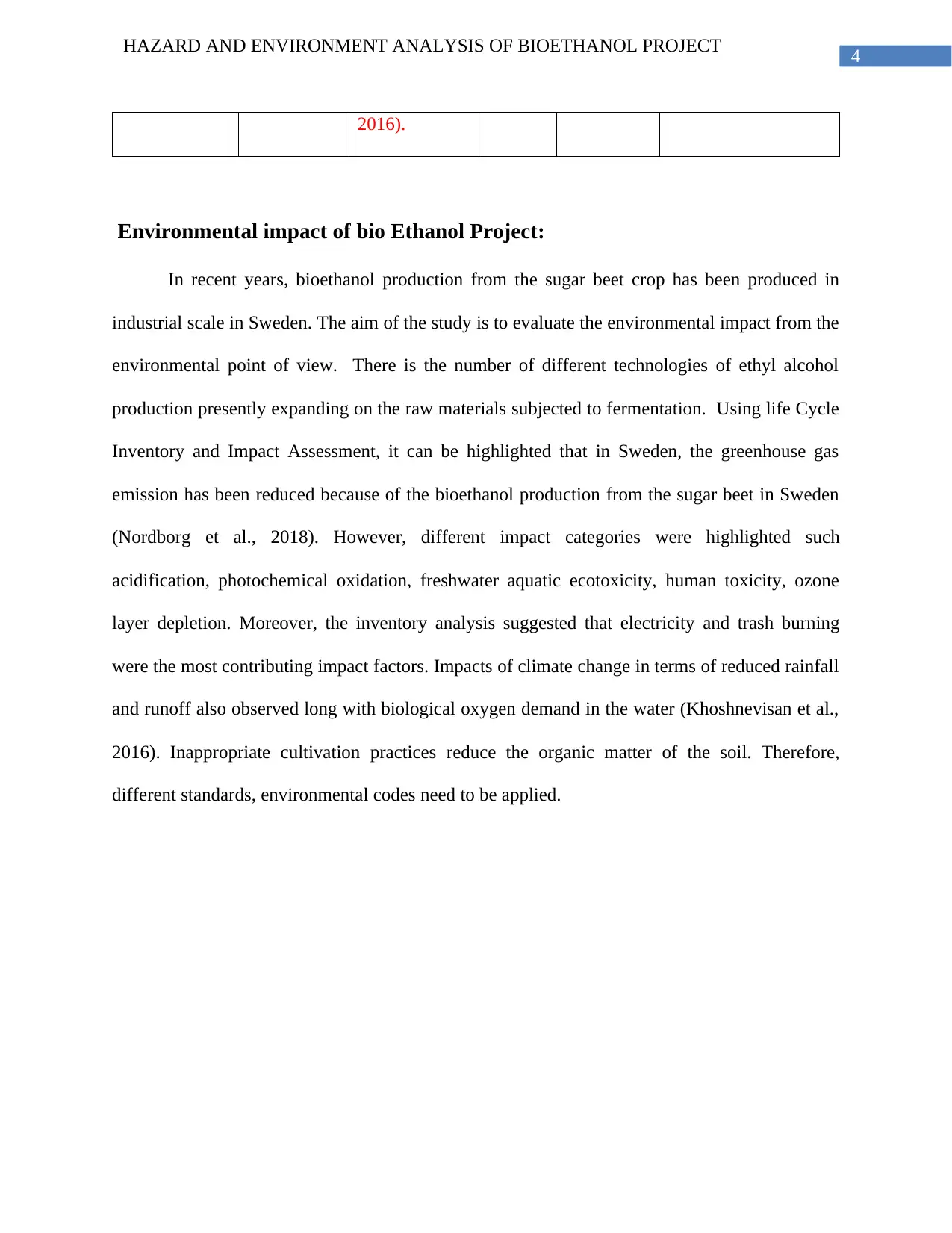
4
HAZARD AND ENVIRONMENT ANALYSIS OF BIOETHANOL PROJECT
2016).
Environmental impact of bio Ethanol Project:
In recent years, bioethanol production from the sugar beet crop has been produced in
industrial scale in Sweden. The aim of the study is to evaluate the environmental impact from the
environmental point of view. There is the number of different technologies of ethyl alcohol
production presently expanding on the raw materials subjected to fermentation. Using life Cycle
Inventory and Impact Assessment, it can be highlighted that in Sweden, the greenhouse gas
emission has been reduced because of the bioethanol production from the sugar beet in Sweden
(Nordborg et al., 2018). However, different impact categories were highlighted such
acidification, photochemical oxidation, freshwater aquatic ecotoxicity, human toxicity, ozone
layer depletion. Moreover, the inventory analysis suggested that electricity and trash burning
were the most contributing impact factors. Impacts of climate change in terms of reduced rainfall
and runoff also observed long with biological oxygen demand in the water (Khoshnevisan et al.,
2016). Inappropriate cultivation practices reduce the organic matter of the soil. Therefore,
different standards, environmental codes need to be applied.
HAZARD AND ENVIRONMENT ANALYSIS OF BIOETHANOL PROJECT
2016).
Environmental impact of bio Ethanol Project:
In recent years, bioethanol production from the sugar beet crop has been produced in
industrial scale in Sweden. The aim of the study is to evaluate the environmental impact from the
environmental point of view. There is the number of different technologies of ethyl alcohol
production presently expanding on the raw materials subjected to fermentation. Using life Cycle
Inventory and Impact Assessment, it can be highlighted that in Sweden, the greenhouse gas
emission has been reduced because of the bioethanol production from the sugar beet in Sweden
(Nordborg et al., 2018). However, different impact categories were highlighted such
acidification, photochemical oxidation, freshwater aquatic ecotoxicity, human toxicity, ozone
layer depletion. Moreover, the inventory analysis suggested that electricity and trash burning
were the most contributing impact factors. Impacts of climate change in terms of reduced rainfall
and runoff also observed long with biological oxygen demand in the water (Khoshnevisan et al.,
2016). Inappropriate cultivation practices reduce the organic matter of the soil. Therefore,
different standards, environmental codes need to be applied.
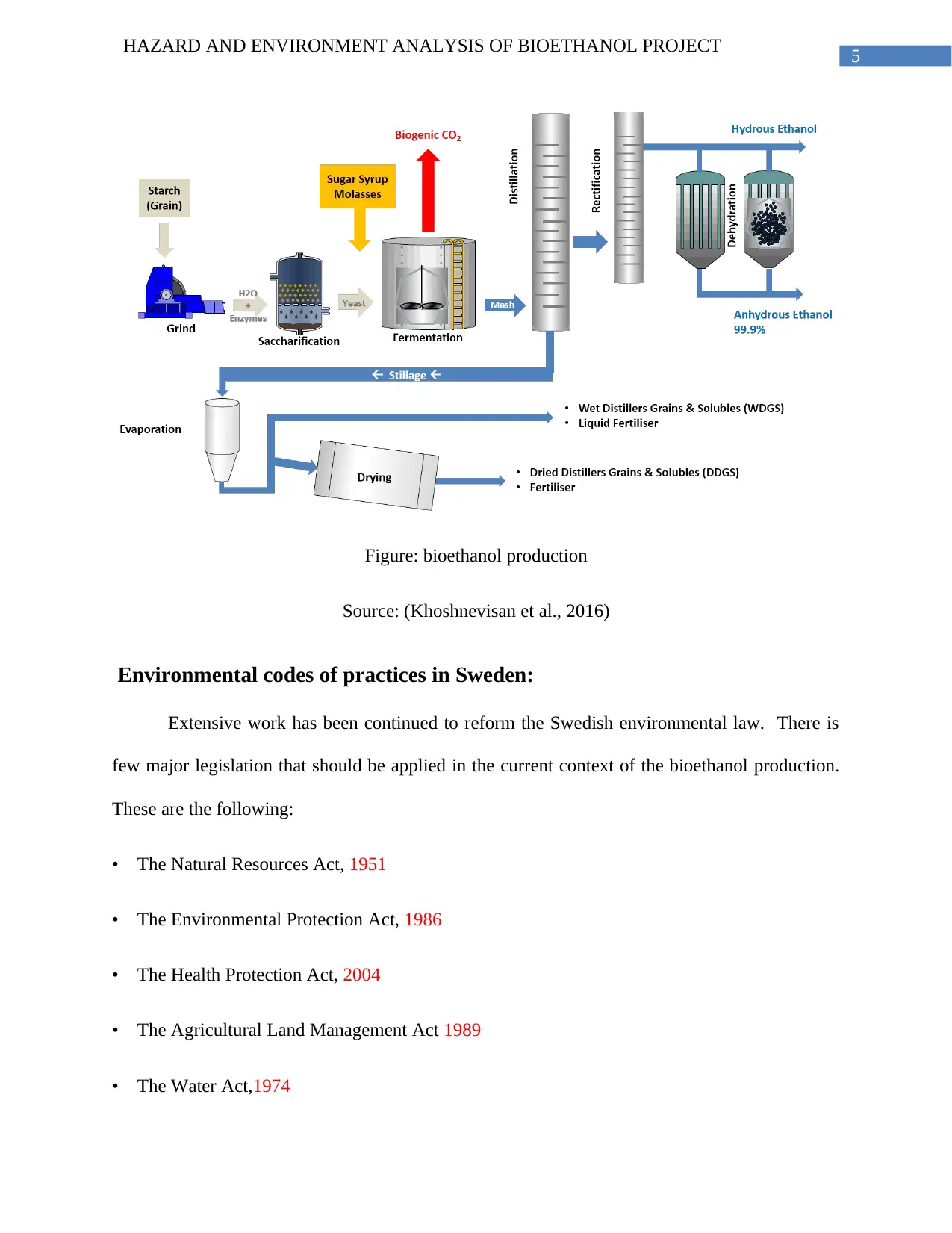
5
HAZARD AND ENVIRONMENT ANALYSIS OF BIOETHANOL PROJECT
Figure: bioethanol production
Source: (Khoshnevisan et al., 2016)
Environmental codes of practices in Sweden:
Extensive work has been continued to reform the Swedish environmental law. There is
few major legislation that should be applied in the current context of the bioethanol production.
These are the following:
• The Natural Resources Act, 1951
• The Environmental Protection Act, 1986
• The Health Protection Act, 2004
• The Agricultural Land Management Act 1989
• The Water Act,1974
HAZARD AND ENVIRONMENT ANALYSIS OF BIOETHANOL PROJECT
Figure: bioethanol production
Source: (Khoshnevisan et al., 2016)
Environmental codes of practices in Sweden:
Extensive work has been continued to reform the Swedish environmental law. There is
few major legislation that should be applied in the current context of the bioethanol production.
These are the following:
• The Natural Resources Act, 1951
• The Environmental Protection Act, 1986
• The Health Protection Act, 2004
• The Agricultural Land Management Act 1989
• The Water Act,1974
⊘ This is a preview!⊘
Do you want full access?
Subscribe today to unlock all pages.

Trusted by 1+ million students worldwide
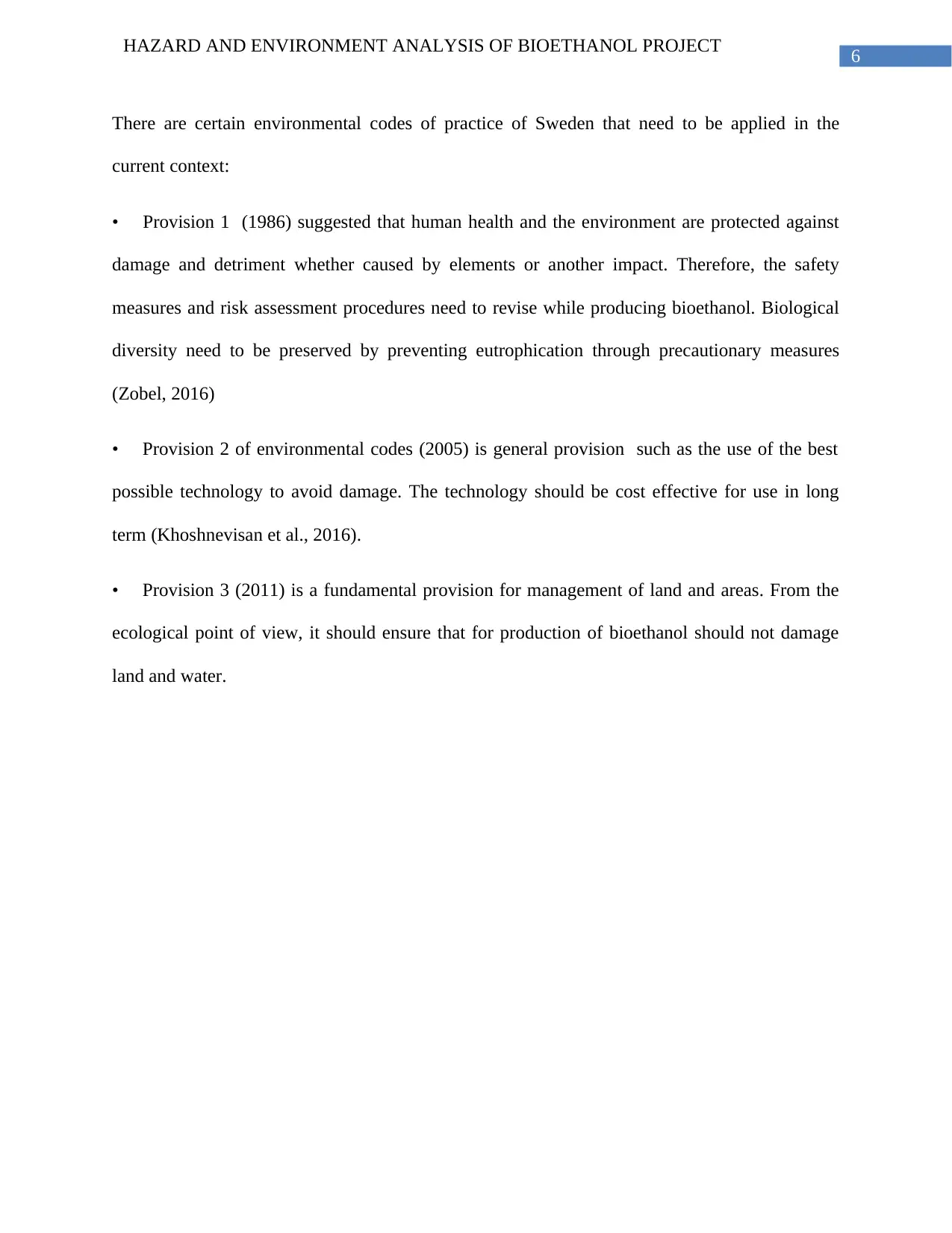
6
HAZARD AND ENVIRONMENT ANALYSIS OF BIOETHANOL PROJECT
There are certain environmental codes of practice of Sweden that need to be applied in the
current context:
• Provision 1 (1986) suggested that human health and the environment are protected against
damage and detriment whether caused by elements or another impact. Therefore, the safety
measures and risk assessment procedures need to revise while producing bioethanol. Biological
diversity need to be preserved by preventing eutrophication through precautionary measures
(Zobel, 2016)
• Provision 2 of environmental codes (2005) is general provision such as the use of the best
possible technology to avoid damage. The technology should be cost effective for use in long
term (Khoshnevisan et al., 2016).
• Provision 3 (2011) is a fundamental provision for management of land and areas. From the
ecological point of view, it should ensure that for production of bioethanol should not damage
land and water.
HAZARD AND ENVIRONMENT ANALYSIS OF BIOETHANOL PROJECT
There are certain environmental codes of practice of Sweden that need to be applied in the
current context:
• Provision 1 (1986) suggested that human health and the environment are protected against
damage and detriment whether caused by elements or another impact. Therefore, the safety
measures and risk assessment procedures need to revise while producing bioethanol. Biological
diversity need to be preserved by preventing eutrophication through precautionary measures
(Zobel, 2016)
• Provision 2 of environmental codes (2005) is general provision such as the use of the best
possible technology to avoid damage. The technology should be cost effective for use in long
term (Khoshnevisan et al., 2016).
• Provision 3 (2011) is a fundamental provision for management of land and areas. From the
ecological point of view, it should ensure that for production of bioethanol should not damage
land and water.
Paraphrase This Document
Need a fresh take? Get an instant paraphrase of this document with our AI Paraphraser

7
HAZARD AND ENVIRONMENT ANALYSIS OF BIOETHANOL PROJECT
References:
Ferreira, J. A., Brancoli, P., Agnihotri, S., Bolton, K., & Taherzadeh, M. J. (2018). Integration of
lignocelluloses and other wastes in 1st generation bioethanol processes. Process
Biochemistry.
Khoshnevisan, B., Shafiei, M., Rajaeifar, M. A., & Tabatabaei, M. (2016). Biogas and bioethanol
production from pinewood pre-treated with steam explosion and N-methylmorpholine-N-
oxide (NMMO): A comparative life cycle assessment approach. Energy, 114, 935-950.
Lazarevic, D., & Martin, M. (2018). Life cycle assessment calculative practices in the Swedish
biofuel sector: Governing biofuel sustainability by standards and numbers. Business
Strategy and the Environment, 27(8), 1558-1568.
Nordborg, M., Berndes, G., Dimitriou, I., Henriksson, A., Mola-Yudego, B., & Rosenqvist, H.
(2018). Energy analysis of willow production for bioenergy in Sweden. Renewable and
Sustainable Energy Reviews, 93, 473-482.
Silveira, S., & Johnson, F. X. (2016). Navigating the transition to sustainable bioenergy in
Sweden and Brazil: Lessons learned in a European and International context. Energy
Research & Social Science, 13, 180-193.
Zobel, T. (2016). The impact of ISO 14001 on corporate environmental performance: a study of
Swedish manufacturing firms. Journal of Environmental Planning and Management,
59(4), 587-606.
HAZARD AND ENVIRONMENT ANALYSIS OF BIOETHANOL PROJECT
References:
Ferreira, J. A., Brancoli, P., Agnihotri, S., Bolton, K., & Taherzadeh, M. J. (2018). Integration of
lignocelluloses and other wastes in 1st generation bioethanol processes. Process
Biochemistry.
Khoshnevisan, B., Shafiei, M., Rajaeifar, M. A., & Tabatabaei, M. (2016). Biogas and bioethanol
production from pinewood pre-treated with steam explosion and N-methylmorpholine-N-
oxide (NMMO): A comparative life cycle assessment approach. Energy, 114, 935-950.
Lazarevic, D., & Martin, M. (2018). Life cycle assessment calculative practices in the Swedish
biofuel sector: Governing biofuel sustainability by standards and numbers. Business
Strategy and the Environment, 27(8), 1558-1568.
Nordborg, M., Berndes, G., Dimitriou, I., Henriksson, A., Mola-Yudego, B., & Rosenqvist, H.
(2018). Energy analysis of willow production for bioenergy in Sweden. Renewable and
Sustainable Energy Reviews, 93, 473-482.
Silveira, S., & Johnson, F. X. (2016). Navigating the transition to sustainable bioenergy in
Sweden and Brazil: Lessons learned in a European and International context. Energy
Research & Social Science, 13, 180-193.
Zobel, T. (2016). The impact of ISO 14001 on corporate environmental performance: a study of
Swedish manufacturing firms. Journal of Environmental Planning and Management,
59(4), 587-606.
1 out of 8
Your All-in-One AI-Powered Toolkit for Academic Success.
+13062052269
info@desklib.com
Available 24*7 on WhatsApp / Email
![[object Object]](/_next/static/media/star-bottom.7253800d.svg)
Unlock your academic potential
Copyright © 2020–2025 A2Z Services. All Rights Reserved. Developed and managed by ZUCOL.

